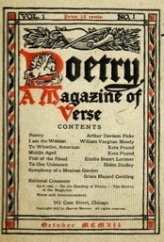October 2012 marks the 100th anniversary of Poetry Magazine — the brainchild and life-long passion of Harriet Monroe. Born in Chicago in 1860, Monroe’s poetry career began at age 29 when Century Magazine published her poem “With a Copy of Shelly.”
While she tried to devote herself full-time to poetry, she needed to earn a living — and there were few opportunities at the time for poets. She later reflected, “The minor painter or sculptor was honored with large annual awards in our greatest cities, while the minor poet was a joke of the paragraphers, subject to the popular prejudice that his art thrived best on starvation in a garret.”
While working as a freelance correspondent for the Chicago Tribune in 1892, she was asked to write a poem to mark the 400th anniversary of Columbus’s arrival in the New World. When the New York World reprinted the poem without her permission, she sued and received a $5,000 judgment.
The monetary award served as seed money for Monroe’s lofty ambition — a respected poetry publication that paid contributors a respectable sum for their work. Monroe realized that to launch her magazine, she’d need to make a commitment to her readers and contributors to be there — and not go under for lack of funds.
She got the brilliant idea to go to 100 prominent Chicago business leaders and ask each to take out a five-year subscription — at a $50 annual fee. With the initial year’s subscriptions coupled with her settlement money, Monroe launched Poetry Magazine in 1912. (First issue pictured above.)
For the publication’s first two years, Monroe served as non-paid editor while working as art critic for the Chicago Tribune. In 1914, she began to devote herself full-time to Poetry Magazine, at a subsidence salary of $50 per month. (About ten years later, she was still pouring all subscription money into the magazine and to pay contributors — but managed to raise her salary to a still-low $100 per month.)
Poetry Magazine has been credited with bringing poetry into the modern age — and democratizing the art. When soliciting work from writers, Monroe promised an open-door policy and “…a chance to be heard in their own place, without the limitations imposed by the popular magazine…this magazine will appeal to, and it may be hoped, will develop, a public primarily interested in poetry as an art, as the highest, most complete expression of truth and beauty.”
Over the century, Poetry Magazine has counted some of the country’s leading poets as among its discoveries. These include: Gwendolyn Brooks, James Merrill, and John Ashbery. The magazine’s biggest coup was the 1915 publication of T.S. Eliot’s “The Love Song of J. Alfred Prufrock.” Other prominent contributors include: Ezra Pound, William Butler Yeats, Wallace Stevens, Carl Sandburg, and William Carlos Williams. Poetry Magazine is currently published by the Chicago-based Poetry Foundation.
Harriet Monroe continued to serve as editor of Poetry Magazine until her death in 1936, at age 75, while in Peru on her way to climb Macchu Picchu. But her beloved publication lives on — what a legacy!
Note: A nod to Wikipedia for information used in this article.




